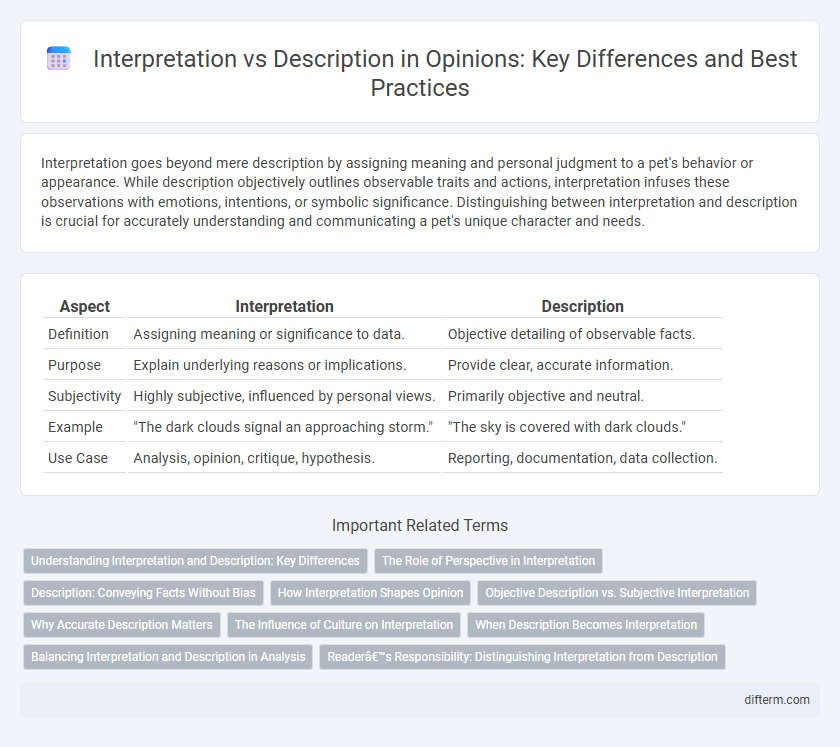Interpretation goes beyond mere description by assigning meaning and personal judgment to a pet's behavior or appearance. While description objectively outlines observable traits and actions, interpretation infuses these observations with emotions, intentions, or symbolic significance. Distinguishing between interpretation and description is crucial for accurately understanding and communicating a pet's unique character and needs.
Table of Comparison
| Aspect | Interpretation | Description |
|---|---|---|
| Definition | Assigning meaning or significance to data. | Objective detailing of observable facts. |
| Purpose | Explain underlying reasons or implications. | Provide clear, accurate information. |
| Subjectivity | Highly subjective, influenced by personal views. | Primarily objective and neutral. |
| Example | "The dark clouds signal an approaching storm." | "The sky is covered with dark clouds." |
| Use Case | Analysis, opinion, critique, hypothesis. | Reporting, documentation, data collection. |
Understanding Interpretation and Description: Key Differences
Interpretation involves analyzing meaning, drawing conclusions, and providing insights beyond the observable facts presented in a description. Description focuses on objectively detailing characteristics, events, or phenomena without inferring significance or underlying causes. Understanding the distinction between interpretation and description is essential for critical thinking and accurate communication in academic and professional contexts.
The Role of Perspective in Interpretation
Interpretation fundamentally depends on the viewer's perspective, as personal experiences, cultural background, and cognitive biases shape the meaning derived from any text or event. Unlike description, which aims for objective representation of facts, interpretation involves subjective analysis that varies between individuals and communities. This dynamic underscores how perspective influences not only what is understood but also why certain interpretations gain traction over others in social discourse.
Description: Conveying Facts Without Bias
Description involves presenting objective facts and observable details without inserting personal judgment or emotional influence, ensuring clarity and neutrality in communication. It emphasizes accurate representation of information, allowing readers to form their own interpretations based on unbiased data. This approach enhances credibility and trustworthiness in conveying information.
How Interpretation Shapes Opinion
Interpretation plays a crucial role in shaping opinion by framing facts through personal experiences, beliefs, and cultural backgrounds. It influences how individuals assign meaning to information, leading to diverse viewpoints even when the underlying data remains constant. The subjective nature of interpretation underscores the importance of critical thinking in evaluating opinions for bias and depth.
Objective Description vs. Subjective Interpretation
Objective description conveys facts and observable details without influence from personal feelings, ensuring clarity and neutrality in communication. Subjective interpretation involves personal insights, emotions, and biases, which can add depth but may compromise impartiality. Balancing both approaches is crucial for comprehensive understanding and effective expression.
Why Accurate Description Matters
Accurate description forms the foundation for objective understanding, allowing interpretations to be based on clear, verifiable facts rather than subjective assumptions. Precise, detailed descriptions minimize miscommunication and bias, enabling more informed and meaningful discussions. This clarity strengthens arguments and supports the development of well-founded opinions.
The Influence of Culture on Interpretation
Cultural background profoundly shapes interpretation by influencing the lens through which individuals perceive and assign meaning to information. Interpretations often vary across cultures due to differing values, beliefs, and social norms, creating diverse understandings of the same descriptive facts. This highlights the importance of acknowledging cultural context to avoid misinterpretation and enhance cross-cultural communication.
When Description Becomes Interpretation
Description becomes interpretation when the observer's personal biases and subjective insights influence the portrayal of facts, blending objective observation with individual perspective. This shift often occurs as descriptive language incorporates assumptions or inferred meanings that extend beyond raw data. Recognizing this boundary is essential for maintaining clarity between neutral reporting and opinion-driven analysis.
Balancing Interpretation and Description in Analysis
Balancing interpretation and description in analysis requires integrating factual details with insightful evaluation to provide a comprehensive understanding. Description grounds the analysis in concrete data, while interpretation offers meaning and context, enhancing the depth of the argument. Effective analysts refine this balance to avoid overemphasizing subjective opinion or reducing analysis to mere reporting of facts.
Reader’s Responsibility: Distinguishing Interpretation from Description
Readers hold the responsibility to critically distinguish interpretation from description, as descriptions provide objective facts while interpretations impose subjective meaning. Effective reading requires analyzing textual evidence to separate observable data from personal inferences, preventing bias or misunderstanding. Developing this skill enhances comprehension and fosters a balanced engagement with the text.
interpretation vs description Infographic

 difterm.com
difterm.com